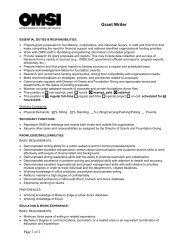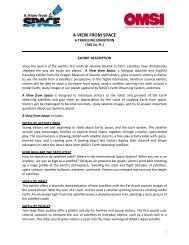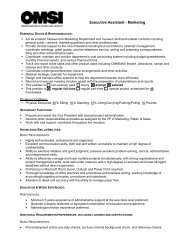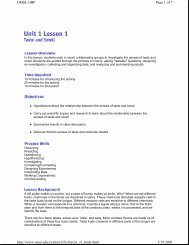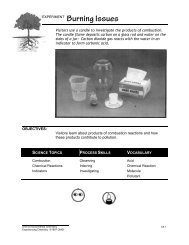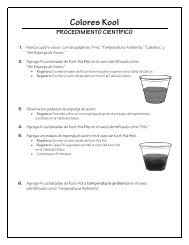ADRENALINE RUSH: THE SCIENCE OF RISK - Big Movie Zone
ADRENALINE RUSH: THE SCIENCE OF RISK - Big Movie Zone
ADRENALINE RUSH: THE SCIENCE OF RISK - Big Movie Zone
Create successful ePaper yourself
Turn your PDF publications into a flip-book with our unique Google optimized e-Paper software.
<strong>ADRENALINE</strong> <strong>RUSH</strong>: <strong>THE</strong> <strong>SCIENCE</strong> <strong>OF</strong> <strong>RISK</strong><br />
Now, you can also build Leonardo’s parachute.<br />
For this experiment, you will need:<br />
1. Four sheets of paper (preferably construction paper)<br />
2. Some string (four lengths of 12 inches or 30 centimeters, and a little extra)<br />
3. A precise ruler<br />
4. A pair of scissors or a box cutter<br />
5. Some light adhesive tape<br />
To Do:<br />
6. Four straws or light sticks (optional)<br />
To prepare an eight-inch high (20 centimeters) parachute,<br />
1<br />
2<br />
3<br />
4<br />
cut four isosceles triangles<br />
8 inches wide (20<br />
cm) and 8 7/8 inches<br />
(22.4 cm) high<br />
(see figure 1).<br />
Figure 1<br />
Tightly tape the sides of<br />
the four faces of the<br />
parachute together to<br />
produce the pyramid<br />
shape.<br />
Tape a piece of string to<br />
each corner, and tape<br />
or tie the end of the<br />
four strings together.<br />
Use some string or tape to attach a light<br />
object to the parachute strings. A wine<br />
cork has just about the right weight for<br />
this size parachute, although you can also<br />
test the effects of lighter and heavier<br />
objects. To make the chute more solid,<br />
straws or light sticks can be used to create<br />
a square frame at the base of the<br />
parachute.<br />
More advanced options:<br />
Figure 2<br />
You can try making models of Leonardo’s parachute in different sizes, and using different<br />
materials like cloth or plastic, by using some basic mathematics to figure out<br />
the proportions. To figure out dimensions, use the Pythagorean theorem (a2 + b2 =<br />
c2). Here’s how.<br />
Leonardo da Vinci specified that his parachute should be “a length of gummed linen<br />
cloth, with a length of 12 yards (“braccia“) on each side and 12 yards high“. Since it<br />
is as high as it is wide, we can use the Pythagorean theorem to create a model of<br />
any size.<br />
Figure 3<br />
For example, for a 12 inches wide parachute (see figure 2) we know that a=12, b=6<br />
(half the total width). This means that the hypotenuse equals the square root of 180<br />
(144+36), or approximately 13.4 inches (13 7/16“). The hypothenuse is the height of<br />
each face of the parachute, meaning that each face should be 12 inches wide and<br />
13.4 inches high (see figure 3) to produce a 12-inch high pyramid. The strings should<br />
be approximately one and a half times the height of the pyramid.<br />
Please note that bigger models will definitely need a frame to keep the opening in<br />
its square shape as the parachute flies. You can also experiment with the weight of<br />
the attached object. If it is too light, the parachute will be unstable. If it is too heavy,<br />
the parachute will fall too fast.<br />
13







